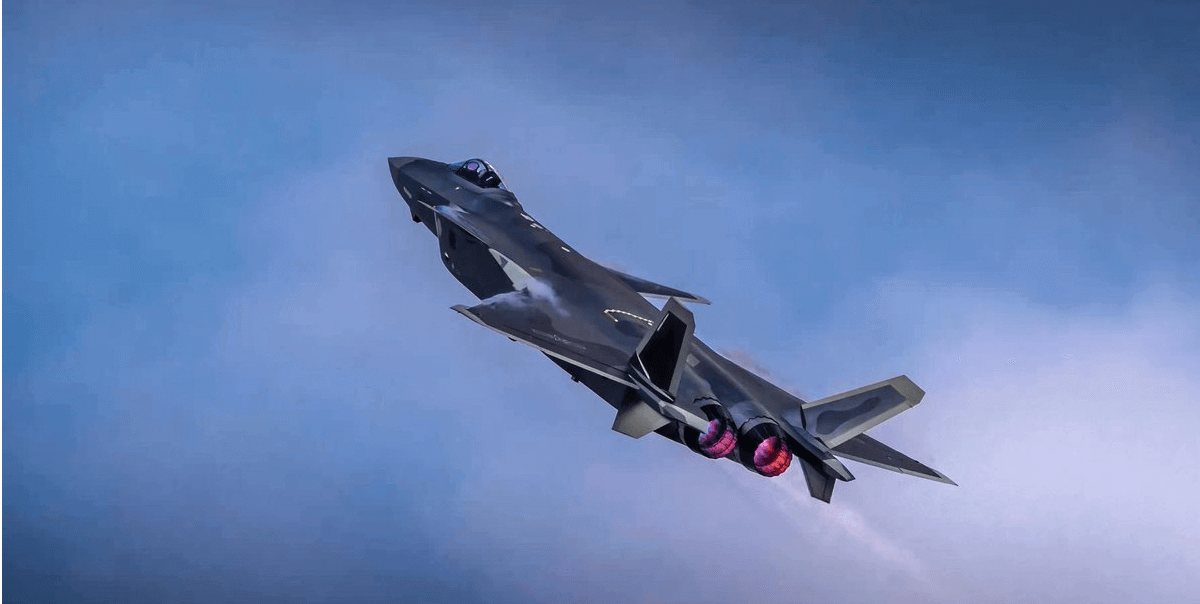China exhibited a turbofan engine with a 2D thrust vectoring control nozzle at the ongoing Zhuhai Airshow 2022. A turbofan engine with a 2D thrust vectoring control nozzle provides enhanced maneuverability and stealth capability.
The Chinese engineers have reportedly been working on this technology to close the gap between the capability of its J-20 stealth fighter and the F-22 Raptor, which uses the thrust vector control nozzle.
The Taihang series of turbofan engines, which come in five variants, are on display at the airshow.
According to the AECC, these five different variants of the Taihang series are used on other aircraft of the PLA Air Force. Once powered by Russian engines, China’s fighter jets like the J-10 and the J-20 are now powered by different variants of Taihang engines.
Even though these Taihang engines have been around for a while, the engine with thrust vectoring control technology caught visitors’ attention at the air show.
The manufacturer or Chinese officials did not directly name the Taihang engine that sported this state-of-the-art technology. However, the engine was expected to be a WS-10 variant, noted military watchers.
According to the state-owned Aero Engine Corp of China (AECC), the Taihang engine has continued to receive technical upgrades that have improved its performance, reliability, safety, stealth capability, power extraction, environmental adaptability, endurance, and thrust vectoring.
Wei Dongxu, a Chinese military expert, told the Global Times at the Air show that thrust vectoring can significantly increase the maneuverability of the fighter jet by providing thrust directly to the desired direction and using aerodynamics.
It has become crucial for the PLAAF to integrate this technology as tensions have risen in the Indo-Pacific. The region is now becoming ‘overcrowded’ with American stealth fighters.
“China’s development of a turbofan engine with a 2D thrust vectoring control nozzle means the engine has sufficient power to manage the loss of some thrust,” Wei said.
A 2D TVC Engine
Could be either a new WS-10 variant (Certainly Not WS-10B TVC ) or
WS-19/XX for J-35 Stealth Fighter ?Best surprise from #ZhuhaiAirShow2022 so far imopic.twitter.com/8RP1PRghsT
— Húrin (@intel1osint100) November 6, 2022
Last year, a J-20 pilot Li Gang said in an interview that he would want the J-20 to be upgraded with 2D thrust vectoring nozzle engines.
Later, in January 2022, China announced that it would begin upgrading the engines of its fifth-generation J-20 stealth fighter jet with modern technology to match the capability of the American F-22 Raptors.
The J-20 is currently believed to be powered by the WS-10C engine.
According to previous reports, the WS-10C is a stop-gap arrangement until the more advanced WS-15 engines are ready for installation. However, the WS-10C, which is also used on other fighter jets of the PLAAF, restricts the capability of the J-20 fighters.
This is where the thrust vector nozzle comes into the picture.
2D Thrust Vector Nozzle Tech To Counter USAF?
According to a Pentagon study, Beijing has been actively modernizing its J-20 fighter jets. China was speculated to add a 2D thrust-vectoring nozzle and an F-22-like “super cruise” capability with domestic WS-15 engines to J-20s.
The Chinese Air Force (PLAAF) has long been trying to close the capability gap with the USAF Raptors. To that end, the WS-15 had been in the works for a long time to power the J-20 and J-31 (FC-31) fifth-generation stealth aircraft, but it was shelved due to a succession of failed tests and evaluations.
The test failures led to China reportedly settling with the homegrown WS-10C.

At the beginning of this year, there were reports that China was finally upgrading the WS-10C engine with thrust vector nozzle technology.
“Because verification of the two-dimensional thrust-vectoring nozzles, the technology used by the F-22, has been completed, the maneuverability and stealth capability of the J-20s will be upgraded,” a person familiar with the engine development program told SCMP.
Thrust vectoring control typically results in some degree of thrust loss since an aero engine with a thrust vectoring control nozzle is mechanically and structurally more complex than an engine without one.
A J-10B fighter jet performed a flight at the 2018 Air show China with a 3D thrust vectoring control nozzle. One of the five Taihang versions, an engine with a 3D thrust vectoring control nozzle, was also on show this year. However, it is noteworthy that a 2D nozzle could lose even more thrust than a 3D nozzle.
珠海航展で展示されている3次元推力偏向ノズルを搭載した中国製WS-10エンジン。
(video via wb/@机飞弹打_航空航天) pic.twitter.com/h60OpFCwmF— お砂糖wsnbn (@sugar_wsnbn) November 6, 2022
Wei told Global Times that China had developed a turbofan engine that includes a 2D thrust vectoring control nozzle, which implies the engine has enough power to handle some thrust loss.
This technology typically allows a jet to fly longer and conduct more elaborate combat missions without refueling as frequently as a conventional fighter jet. The F-22 Raptors that will now be stationed in Japan at the Kadena Air Base have this technology that the Chinese have been trying to master for two decades.

According to Fu Qianshao, a Chinese military aviation expert, a 2D nozzle is typically preferable if the engine can provide enough power because it typically has superior radar and infrared stealth potential than a 3D nozzle. 2D nozzles are rectangular, and 3D nozzles are circular, which means the former has better infrared and stealth capabilities.
At a press conference for Airshow China 2018, Yang Wei, the principal designer of the J-20, was asked when the aircraft can obtain thrust vectoring-capable engines. He responded, “You asked about when, but how do you know it hasn’t?”
Military watchers interpreted this comment broadly to mean that the J-20’s designers have been extensively testing thrust vector control on the aircraft with the display at the ongoing show as evidence that the capability is very much developed and, possibly, even integrated.
- Contact the author at sakshi.tiwari9555(at)gmail.com
- Follow EurAsian Times on Google News




